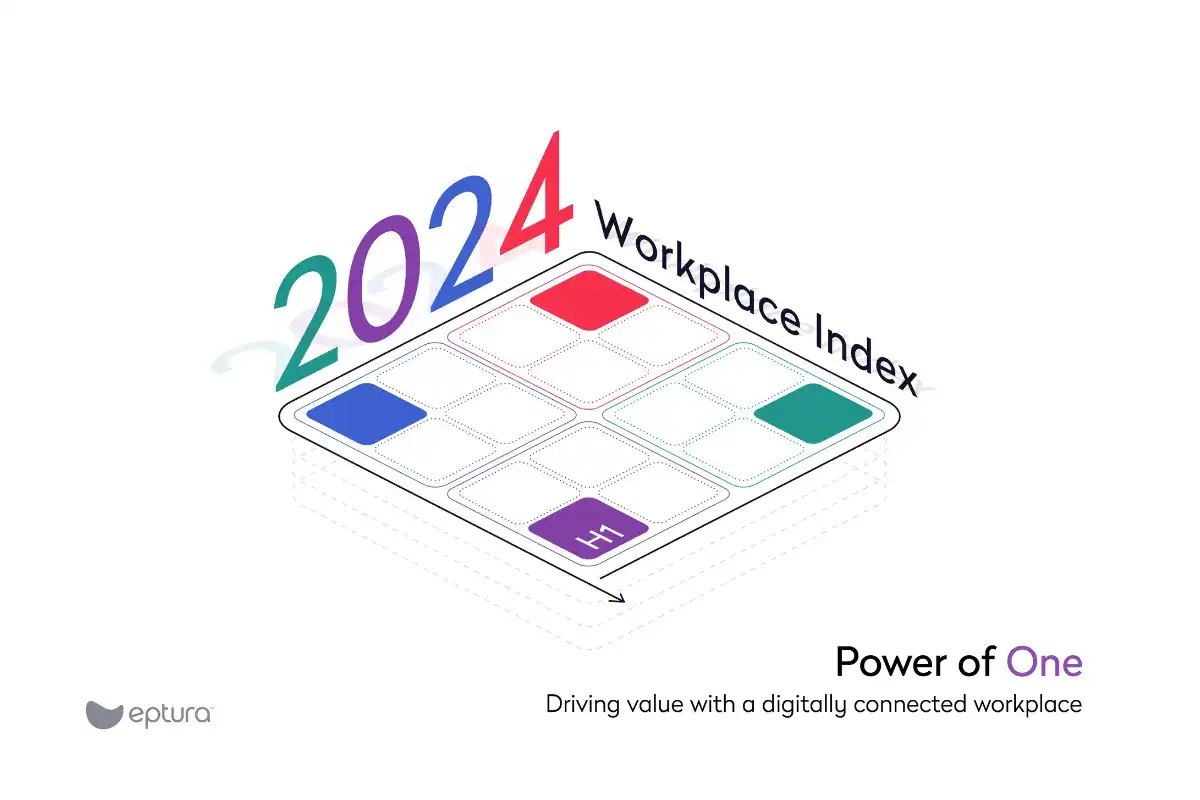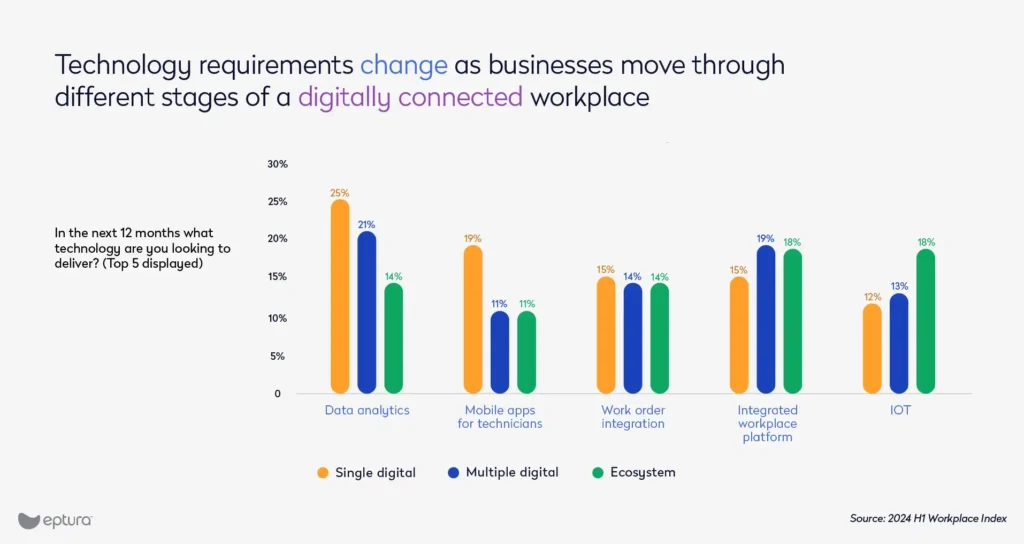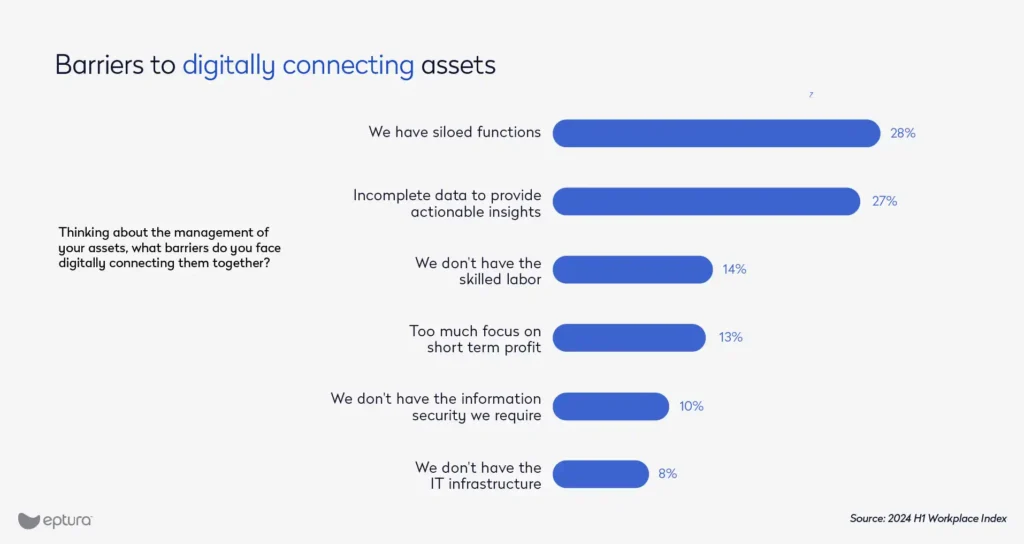
Successfully implementing enterprise-wide change requires careful planning and execution. To create a digitally connected workplace, an organization must coordinate many people, spaces, and assets across four evolutionary stages. Our proprietary research reveals the two biggest reported barriers to transformation are measuring success and change management.
But two of the defining elements of a connected, unified platform – stronger communication and automated data capture — means that as an organization makes progress toward a digital ecosystem, it also becomes better able to manage the complexities of change.
Eptura’s H1 2024 Workplace Index draws on independent research on enterprise companies across North America, Europe, and Asia Pacific, with insights from C-level, vice-president, and country-head leaders across departments, and includes anonymous user data from more than 5,000 companies, including 19,000 buildings, 95.5 million desk bookings, and 25 million room bookings.
How do larger companies benefit from a connected workplace?
A connected workplace is a digitally integrated environment that unifies people, processes, and technology to foster seamless communication, collaboration, and data sharing. For large companies, especially those with multiple locations, there are many benefits to a connected workplace, especially related to how it empowers departments across the enterprise to leverage data.
For example, the organization can use data analytics to identify regional trends, optimize resource allocation, and predict local market needs, driving operational efficiency and cost savings. And employees across different locations can access and share information instantly, reducing duplicated efforts and accelerating problem-solving.
Collective intelligence is able to drive innovation and improve overall productivity. A connected workplace also helps with data security and compliance. Centralized data management ensures standardized security protocols and simplifies regulatory compliance across multiple locations.
Our research reveals industry leaders are excited about embracing the connected workplace.
We asked operational leaders about the technology their business intended to implement in the next 12 months for three key areas: employee experience, building and facilities, and asset management.
The top three for employee experience were:
- 25% Workplace analytics
- 25% Collaboration software
- 15% AI predictive booking
For buildings and facilities, the top tech was:
- 17% Data analytics
- 15% Integrated platform
- 13% Facility requests in workplace solutions
The responses for asset management echoed the other results, with:
- 22% Data analytics
- 17% Integrated workplace platform
- 15% Work order integration into workplace solutions
The current stage of digital transformation can affect which technologies organizations want to implement first.

But as a consistent trend, leaders across industries can see the value of a connected workplace. At the same time, they report challenges when trying to make progress toward implementation.
What are the most common challenges when trying to create a connected workplace?
When we asked operational leaders, “What is your organization’s biggest challenge in transforming your workplace or implementing new programs?”, the answers centered on change management, with:
- 37% Measuring the success and impact of change
- 25% Implementing a workplace change management program
- 16% Identifying and communicating vision and strategy
- 12% Understanding best practice
- 9% Identifying and selecting suitable technology vendors
- 1% Other
It’s important to note that although there are sets of common concerns, our research highlights how different factors can affect which challenges an organization is most likely to report.
Implementation challenges connected to stage of digital transformation
In some cases, it’s correlated with their current stage of digital transformation. In our earlier explorations of the Workplace Index report, we looked at how digital transformation involves four stages. In Stage 1, large corporations transition from manual methods to single-point digital solutions. For example, they might replace paper-based visitor logs with a modern digital visitor management system.
While this improves data capture and reduces loss, data remains relatively siloed, offering limited visibility. Stage 2 involves bundling multiple solutions from a single vendor to cut management and software costs, while by Stage 3, organizations adopt an integrated platform that enables cross-platform functionality and data sharing, enhancing operational efficiencies and decision-making—for instance, using occupancy data to schedule maintenance during off-peak hours.
Broader visibility helps identify improvement opportunities. Stage 4 means an integrated ecosystem delivering real-time predictive analysis and modeling, supported by Internet of Things (IoT) devices and digital twins. Here, organizations can leverage a smart, interconnected system to optimize facilities, assets, and employee experiences across multiple locations, achieving a holistic view of the enterprise.
At each stage, an organization is able to build on past successes, progressively enhancing data integration, operational efficiency, and visibility for better decision-making and improved outcomes.
When asked, “What barriers do you face digitally connecting assets?”, the top three answers from operational and maintenance leaders were related to the people and processes connected to data capture.

But inside those answers, we found stage-based differences. Companies in Stage 1 worried more about siloed functions, but those in Stage 2 said incomplete data was the biggest barrier. At Stage 4, companies still worried about siloed and incomplete data, but they were more unconcerned about skilled labor. Companies in the first two stages were at 14%. Those at Stage 4 were less than half that, at just 6%.
An interesting outlier was how the perceived challenges related to meeting sustainability goals remain the same regardless of digital transformation stage.
Implementation challenges connected to hybrid work model policies
We also found trends that appear tied to how a company was implementing the hybrid work model, with three broad categories: company-mandated, employee-led, and manager-led policies.
Companies with employee-led policies consider “understanding best practice” to be the biggest barrier, while businesses with company-mandated and manager-led hybrid policies reported “identifying and communicating vision and strategy” and “identifying and selecting suitable technology vendors” as more significant.
Of the top three most common responses, the biggest differences were in the number of companies that said “Identifying and communication vision and strategy” was the biggest obstacle. A full 19% of companies with mandated days in the office said this was a challenge, while only 6% of companies that let employees take the lead on policies. “Implementing a workplace change management program” showed the smallest difference between policies, a small 3-percentage-point gap.
How can a large organization implement a successful change management program?
The two most common responses in our research remained consistent: “Measuring the success and impact of change” and “Implementing a workplace change management program.” So, regardless of transformation stage or internal policies, most organizations can benefit from a deeper understanding of change management, including sharing information and tracking progress.
In a recent Eptura webinar, “The future of facility and change management,” host Mike Petrusky and guest Marc Weigum, Senior Director of Cumming Group and Founder of Unified Purpose, cover the importance of change management and its role in the future of facility management. Throughout the discussion, Weigum emphasizes the need for facility management professionals to be comfortable with change because often they are the ones implementing it.
“We are change agents. That is really at the core of what we do. We enable change.”
One of the challenges of change is that others might still prefer older ways of working. “We are dealing with people and change, and sometimes they’re not comfortable with it.”
What are the key elements of a change management program?
Change management in large enterprise-level organizations refers to a structured approach to transition individuals, teams, and the entire company to a new state, aiming to minimize resistance and maximize engagement. For large enterprises, effective change management is especially important because of the complexity and scale of both the existing and new elements.
Change management programs typically include several key components:
- Assessment: Evaluating the current state, identifying the need for change, and understanding the impact on all stakeholders.
- Planning: Developing a detailed roadmap that outlines the steps, timelines, and resources required to implement the change.
- Leadership alignment: Ensuring that leaders at all levels are aligned and actively supporting the change, as their buy-in is critical for successful implementation.
- Communication: Clearly and consistently communicating the reasons for the change, the expected benefits, and the roles and responsibilities of all involved.
- Training and support: Providing the necessary training, resources, and support to help employees adapt to the new processes or technologies.
- Monitoring and adjustment: Continuously monitoring the progress of the change initiative, gathering feedback, and adjusting as needed to ensure success.
Effective change management in large enterprises helps to mitigate risks, reduce resistance, and ensure that the desired outcomes are achieved, ultimately contributing to the organization’s long-term success.
How can a company leverage a connected, unified platform to measure the success and impact of change?
One of the many benefits of implementing intelligent worktech on a unified platform that pulls together workplace and facility management is that the solution automates and simplifies much of the change management tracking.
Adoption and usage
Look at user adoption rates by tracking the percentage of users who have started using the new technology. You can also look at login and access frequency to see how often users log in or access the new tools. In earlier stages of the digital transformation, there might be fewer daily users, but as the company implements and connects additional features, more of the employees’ daily work life will be connected to and supported by the platform.
Make sure to also track feature utilization to measure which are more popular. Once you know what people are adopting now, you can make better decisions about which future features to offer and how soon to implement them.
Efficiency and productivity
Moving operations and maintenance to a digital solution empowers departments to track reductions in process times, including, for example, the percentage of work orders that are preventive vs reactive, time on wrench, and maintenance backlogs. Tracking maintenance metrics and key performance indicators like mean time between repairs can also reveal error reduction and better compliance with industry best practices and standard operating procedures.
For employees using the office spaces, you can also leverage data on reservations for desks and meeting rooms to track utilization trends.
User satisfaction and feedback
An important part of managing change is ensuring everyone feels included and heard. Surveys on user satisfaction can help you gather qualitative feedback and net promoter scores (NPS), while tracking support tickets helps them monitor the volume and nature of any issues or areas of confusion. Organizing focus groups or focus interviews is an important step to gaining deeper insights into user experiences and perceptions.
By focusing on these areas and using a mix of quantitative and qualitative metrics, companies can gain a comprehensive understanding of the success and impact of technology-related change. Regularly reviewing and adjusting these measurements will help ensure that the new technology continues to deliver value and support the organization’s goals.
Implementing the right intelligent workplace tech make future change management easier, more effective
Organization-wide change can be a complex process because it involves many people, spaces, and assets across multiple stages of transition. But, as you advance through the stages, overcoming the most common challenges can become increasingly manageable. When transitioning toward a connected workplace, the necessary tools for effective change management — including clear communication channels and comprehensive tracking systems — are already integral to a unified solution.
While the interconnected nature of the system facilitates communication, allowing for clear and consistent messaging across all levels of the organization, the tracking capabilities provide valuable insights and data, enabling you to measure the impact of changes and make informed decisions. As the organization progresses toward a connected workplace, it becomes better equipped to handle the complexities of change.








